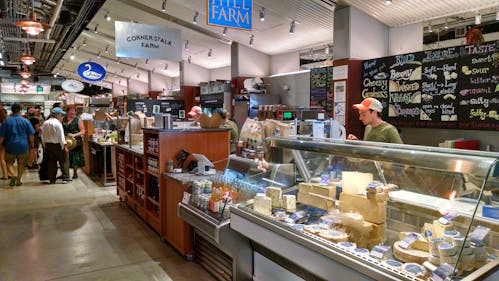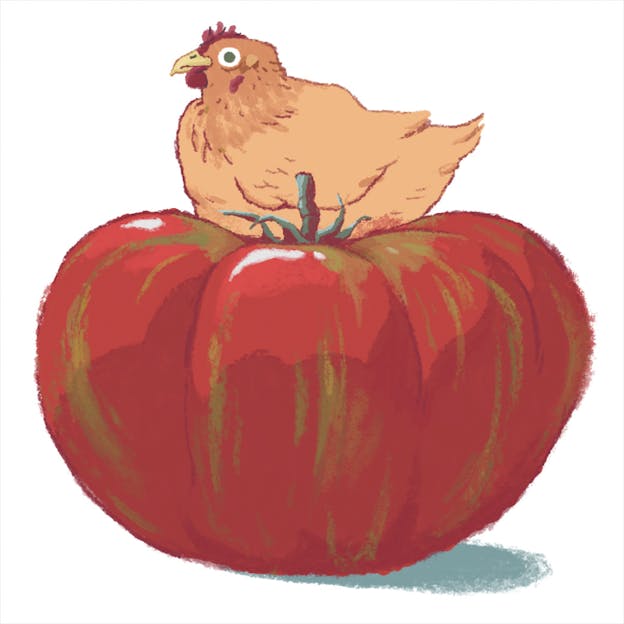You could do surgery back there,” Andy Pollock said, pointing to the five prep sinks in his 200-square-foot stall in the new Boston Public Market, the country’s only year-round covered food market with a mandate to sell foods made almost entirely from locally grown ingredients. Getting the market open this July was a 14-year effort that involved raising $9 million in private funds, winning over state and local officials to provide $6.5 million in buildings and benefits, and lining up more than 35 local businesses willing to take their chances that they would have enough goods to sell—and customers to buy them—during the interminable Boston winter.
Pollock had gone to great lengths in anticipation of the first cold season: He planted extra salad greens in his 30,000-square-foot greenhouses and extra winter squashes and potatoes at Silverbrook Farm, in the idyllic coastal town of Dartmouth, Massachusetts, an hour and a half from Boston. But like the market’s chocolatiers, juice pressers, bakers, tea brewers, pastrami smokers, and mozzarella makers frantically unpacking crates and trying to make display cases stay cold, he was concentrating on getting through the next seven hours. Then the Boston Inspectional Services officers bearing clipboards would approve his stand, or wouldn’t, in time for an opening reception for many of the people who had gone to community hearings, sat through design and planning meetings, sifted through hundreds of vendor applications, given large donations, and stuffed flyers into envelopes.

As any regular farmers’ market visitor knows, a good market is about more than buying food—it’s about striking up conversations, exchanging information, feeling part of a community and actively contributing to it. Along with subways and buses, a public food market is one of the only places left for people of different economic classes to encounter one another, and even ... strike up a conversation.
A true market has as much rutabaga, bargain-priced chicken thighs, chunks of cheese, fruits, vegetables, and fish collars as it does, say, bean-to-bar chocolate from Taza—a company in nearby Somerville that has rightly won a national reputation and customer base—and superior hand-pulled mozzarella, like the one made with local milk at Wolf Meadow Farm, in Amesbury. Not everyone can pay $9 for half a hand-cured pastrami sandwich from Maine grass-fed beef on hand-cut rye bread from Boston’s best baker, Clear Flour, even if I admit to being thrilled that the brand-new Beantown Pastrami is trying to make pastrami in long-deprived Boston. The sinks, vents, ADA-compliant ramps, and the like virtually mandate selling prepared foods. A few too many gourmet grilled-cheese vendors, though, with their higher margins, can soon turn a high-minded populist market into a food court.
Thus the collision course so many other public markets have set, or found, themselves on: either precious and overpriced boutique collections, hokey theme parks two steps more “local” than Knott’s Berry Farm, or down-at-the-heels wholesalers that look little different from the car-part shops on the same block. Boston Public Market is trying to achieve an elusive balance: pleasing the people who now consider artisanal, local food to be a basic human right, and people who just need to get dinner on the table.

Take those five sinks (one each for hand washing, food prep, vegetable washing, rinsing, and sanitizing knives and cutting boards), a somewhat extreme extension of the public health measures introduced for food markets by, among others, the pushcart-hating Mayor Fiorello La Guardia to get vermin-attracting peddlers off the New York City streets. Without those sinks, Silverbrook wouldn’t be able to offer samples of sliced tomatoes, because the knives used to cut them might pick up bacteria from cutting watermelon radishes if they are not washed. (Don’t even think of those times you popped yellow cherry tomatoes or Kentucky wonder beans into your mouth straight from the crate—do you have any idea of the risks you were taking?) This is one of the reasons farmers’ markets are so often in parks and parking lots rather than actual buildings.
Real success for Boston will mean appealing to many kinds of people: the tourists who clog Quincy Market just next door; the office workers from the adjacent financial district; the subway riders who use the four nearby stops; and, to my mind the most necessary group, the people who flock every Friday and Saturday to the open-air Haymarket for dirt-cheap, middling-quality, not-so-fresh, seldom-local produce and meat. Haymarket’s “success needs to be our success,” Liz Morningstar, the Boston Public Market’s CEO, told her board soon after taking the job two years ago. She did not want to turn a cold brick shoulder to the non-artisan shoppers, including those who rely on food stamps, just outside her doors.
Idealistic inclusiveness, then, is much harder to put into practice than to write into a fund-raising prospectus or architect’s program. Equipping vendors to take Supplemental Nutrition Assistance Program (SNAP) isn’t as easy as it sounds, Morningstar told me. Honey, for instance, is popular with Asian customers, including ones who pay with SNAP, and Chinatown is just one neighborhood over. But a local specialist like the Boston Honey Company is ineligible to take snap if it doesn’t sell the usda’s full “market basket” of foods. Morningstar went through bureaucratic hoops to act as a clearinghouse for vendors so that customers can use snap for every eligible product at the market; each stand selling produce participates in Bounty Bucks, a Boston city program that matches up to $10 a day for SNAP purchases of fresh produce from farm vendors.
Watching the Boston Public Market come to life over its first few weeks was like watching a seesaw seeking equilibrium. I had fresh in mind an example of a market that sinks, or maybe rises, to the wrong end: Union Market, just past a neighborhood of luxury-condo mid-rises in northeast Washington, D.C., that seems to have sprung up from a razed wasteland. The market looks like the backdrop of a cosmetics ad: a gorgeous brick factory-style building on the site of a historic market rebuilt after a fire and painted bright white, with one scarily shiny and all-too-kempt food boutique beside another.
It’s one and a half blocks from a wholesale market of unkempt low brick buildings with heavily padlocked metal storefront gates. On the Saturday I visited, I saw families patiently waiting in a line that snaked through the aisles and out the doors of a large meat store selling big cuts of lamb, beef, goat, and fish, almost all of them frozen. After they paid, they waited again to have their cuts re-butchered by several workers with band saws. Every person in line was a person of color. Many didn’t speak English. It was a picture both captivating and deeply disturbing: There was no apparent overlap between old and new. Union Market might as well have imported its own micro-climate from Georgetown.
I’m aware of the counterargument to neighbors who fear gentrification and think seediness should be preserved for its own sake. Just now a battle is going on between longtime residents of St. Roch, the New Orleans neighborhood where two young white developers, neither of them born in the city, are reviving the nineteenth-century market of the same name, which sat empty for the decade after Hurricane Katrina. Concerned activists say residents won’t be able to afford to shop at the glossy new stands. A longtime neighbor of the market recently told me he’s thrilled a spot he grew up near and remembers as a ramshackle, dangerous place will be given new life. “You know who loves the new market?” he asked me. “Poor people! They want a nice place to shop, too!”
Mess, swept up at the end of every day, is part of what makes markets real. Grit should be part of the planning. Gray, low-ceilinged, crowded Boston Public Market already has it. And grit is what makes Essex Street, on the Lower East Side, my favorite market. There’s a mix of upscale sellers (two of the best cheesemongers in the country, Saxelby and Formaggio Kitchen), artisans (the bright youngish Greek woman who left a law firm to bake pastries), the matchlessly idiosyncratic Shopsin’s restaurant, and bodega-style produce vendors that have lousy signage and look unchanged since the late ’70s. It’s what makes Reading Terminal Market, in Philadelphia, so authentic, even if it’s authentically kitschy and the ratio of prepared to fresh food is too high, as it is at the similarly kitschy Fairfax “Original Farmers Market” in Los Angeles. Ferry Building Marketplace, on San Francisco’s Embarcadero, veers too much toward Union Market indoors for my taste, but the farmers’ market in the back, happily chaotic and brilliantly diverse, rescues it from the precious. Perhaps the most successful and authentically charming market in the country is Cleveland’s West Side Market: Built in 1912 and adorned with Guastavino tiles in the style of Grand Central Terminal, it’s home to sausage makers, bakers, and non-quaint local food vendors.
The line between planned character and sterile perfection can be narrow. Of the markets I’ve seen, the one that stands the best chance of hitting that balance by design rather than serendipity is Boston. But maybe I’m partisan because I’m like my New Orleans friend: I want a nice place to shop. Just not too nice, please.
